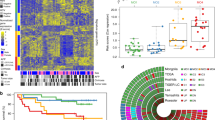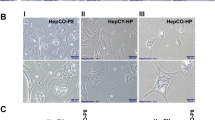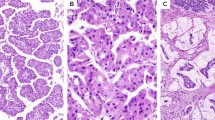Abstract
A recent study revealed that the p110α (PIK3CA), catalytic subunit of phosphatidylinositol 3-kinase (PI3K), is somatically mutated in many types of cancer. For example, PIK3CA is mutated in an estimated 35.6% of hepatocellular carcinoma (HCC) cases. To measure the frequency of PIK3CA hotspot mutations in Japanese HCC patients, exons 9 and 20 of the PIK3CA gene were sequenced in 47 clinical HCC samples. Contrary to expectations, no hotspot mutations were found any of the HCC samples. In addition, we found abnormally migrating waves near the end of exon 9 in the PCR chromatograms from 13 of the 47 samples. PCR amplification and subsequent cloning and sequencing revealed that these chromatograms contained two distinct sequences, the wild-type p110α sequence and a different sequence found on human chromosome 22q11.2, the Cat Eye Syndrome region, which contains a putative pseudogene of PIK3CA. These abnormally migrating waves were also found in noncancerous liver tissue, indicating that this was not a result of HCC-associated mutations. Therefore, it is likely that the percentage of hotspot mutations in the PIK3CA gene of Japanese HCC patients is lower than was previously reported.
This is a preview of subscription content, access via your institution
Access options
Subscribe to this journal
Receive 50 print issues and online access
$259.00 per year
only $5.18 per issue
Buy this article
- Purchase on Springer Link
- Instant access to full article PDF
Prices may be subject to local taxes which are calculated during checkout

Similar content being viewed by others
References
Campbell IG, Russell SE, Choong DY, Montgomery KG, Ciavarella ML, Hooi CS et al. (2004). Cancer Res 64: 7678–7681.
Cantley LC . (2002). Science 296: 1655–1657.
Ikenoue T, Kanai F, Hikiba Y, Obata T, Tanaka Y, Imamura J et al. (2005). Cancer Res 65: 4562–4567.
Kang S, Bader AG, Vogt PK . (2005). Proc Natl Acad Sci USA 102: 802–807.
Lee JW, Soung YH, Kim SY, Lee HW, Park WS, Nam SW et al. (2005). Oncogene 24: 1477–1480.
Levine DA, Bogomolniy F, Yee CJ, Lash A, Barakat RR, Borgen PI et al. (2005). Clin Cancer Res 11: 2875–2878.
Li VS, Wong CW, Chan TL, Chan AS, Zhao W, Chu KM et al. (2005). BMC Cancer 5: 29.
McDermid HE, Morrow BE . (2002). Am J Hum Genet 70: 1077–1088.
Or YY, Hui AB, To KF, Lam CN, Lo KW . (2005). Int J Cancer 2005 August 19 [E-pub ahead of print].
Saal LH, Holm K, Maurer M, Memeo L, Su T, Wang X et al. (2005). Cancer Res 65: 2554–2559.
Sahin F, Kannangai R, Adegbola O, Wang J, Su G, Torbenson M . (2004). Clin Cancer Res 10: 8421–8425.
Samuels Y, Diaz Jr LA, Schmidt-Kittler O, Cummins JM, Delong L, Cheong I et al. (2005). Cancer Cell 7: 561–573.
Samuels Y, Wang Z, Bardelli A, Silliman N, Ptak J, Szabo S et al. (2004). Science 304: 554.
Shayesteh L, Lu Y, Kuo WL, Baldocchi R, Godfrey T, Collins C et al. (1999). Nat Genet 21: 99–102.
Velho S, Oliveira C, Ferreira A, Ferreira AC, Suriano G, Schwartz Jr S et al. (2005). Eur J Cancer 41: 1649–1654.
Vivanco I, Sawyers CL . (2002). Nat Rev Cancer 2: 489–501.
Acknowledgements
This work was supported in part by the Health Science Research Grants for Medical Frontier Strategy Research from the Ministry of Health, Labor, and Welfare of Japan, and the Grants-in-aid for scientific research from the Ministry of Education, Culture, Sports, Science, and Technology of Japan.
Author information
Authors and Affiliations
Corresponding author
Rights and permissions
About this article
Cite this article
Tanaka, Y., Kanai, F., Tada, M. et al. Absence of PIK3CA hotspot mutations in hepatocellular carcinoma in Japanese patients. Oncogene 25, 2950–2952 (2006). https://doi.org/10.1038/sj.onc.1209311
Received:
Accepted:
Published:
Issue Date:
DOI: https://doi.org/10.1038/sj.onc.1209311
Keywords
This article is cited by
-
Targeted genomic profiling identifies frequent deleterious mutations in FAT4 and TP53 genes in HBV-associated hepatocellular carcinoma
BMC Cancer (2019)
-
HBx-induced MiR-1269b in NF-κB dependent manner upregulates cell division cycle 40 homolog (CDC40) to promote proliferation and migration in hepatoma cells
Journal of Translational Medicine (2016)
-
Phase I/II study of temsirolimus for patients with unresectable Hepatocellular Carcinoma (HCC)- a correlative study to explore potential biomarkers for response
BMC Cancer (2015)
-
Exploration of liver cancer genomes
Nature Reviews Gastroenterology & Hepatology (2014)
-
PIK3CA hypomethylation plays a key role in activation of the PI3K/AKT pathway in esophageal cancer in Chinese patients
Acta Pharmacologica Sinica (2013)



